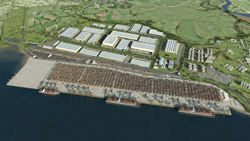London Gateway could boost flows of components by rail
 Rail services for automotive parts in the UK could grow with the launch of services this year by DB Schenker at DP World London Gateway, a new port outside London that starts operations in the fourth quarter of this year.
Rail services for automotive parts in the UK could grow with the launch of services this year by DB Schenker at DP World London Gateway, a new port outside London that starts operations in the fourth quarter of this year.
According to Adrian Fleming, head of sales and marketing at DB Schenker Rail UK, the rail provider plans to launch rail services that will connect London Gateway with the Midlands, Yorkshire, the Northwest and Scotland. The trains will carry a range of container sizes, while DB Schenker is currently exploring the potential for full, half and part-length trains.
Fleming, who was speaking at a special Automotive Logistics Forum organised at the port, said that these services could plug into DB Schenker’s wider European flows to the UK for automotive parts. Such services to the UK for components currently include a daily train from Italy, three times per week from Spain and twice weekly from Poland.
Fleming also pointed to the potential to move export component flows from the UK’s manufacturing regions. He admitted that balancing return flows for DB Schenker’s current automotive rail services was currently challenge.
“We’ve invested in a new IT system that will help us to offer better visibility of freight,” said Fleming.
Along with its component flows, DB Schenker runs a number of finished vehicle train services connected to UK ports to handle imported or exported vehicles. These services include Ford at Dagenham, Jaguar and Land Rover exports from Southampton, PSA at Portbury and BMW Mini from Oxford to Purfleet and Southampton.
London Gateway, however, currently has no plans for a ro-ro or finished vehicle terminal. Any finished vehicles that would move to or from the port by rail would move in containers.
DB Schenker is the first rail operator to agree to run services at London Gateway. The port is building six rail sidings and will be connected to the main UK rail network by a double track branch line. It will be capable of running 750 metre length trains.
London Gateway, which is about 40km east of central London on the north bank of the river Thames, is expected to have 1.5m TEU capacity by next year, and eventually 3.5m TEU when all of its berths open. It also has plans to build Europe’s largest logistics park. Peter Ward, commercial manager for cargo supply chain at the port, pointed out that the port’s location could save manufacturers inland logistic cost to points serving the London region, as well as Birmingham, the Midlands and Manchester. In comparison to other southern ports, Ward said that Drewry estimates savings per container of $300 to London and $95 to other regions. (Read more here and see an exclusive webinar here).





